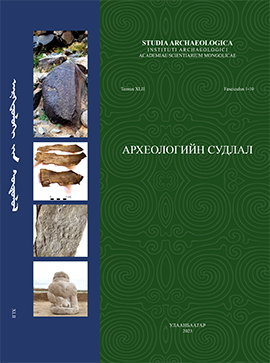A Newly discovered neolithic site from the south bank of the Kherlen river
DOI:
https://doi.org/10.5564/sa.v42i1.2815Keywords:
Khalgaityn Bulan, Neolithic period, core, tool, pottery shardsAbstract
More than 1,000 sites related to the Paleolithic, Mesolithic, and Neolithic periods have been discovered and recorded in the territory of Mongolia. These sites are principally found along large and small river valleys, in sheltered areas, near sand dunes, or around ancient lakes and other bodies of water. The artifacts from most of these sites consist of stone tools and pottery shards. These assemblages are often found on the surface in the form of in situ settlements, with most being considered to be Holocene in age. In addition to the above-mentioned artifacts, it is common to find many types of artifacts made of beads, bronze, cast iron, and iron, as well as human and animal bones. The mixing of related artifacts from different periods of history in a certain place is undoubtedly related to the unique climatic conditions of Mongolia that hinder sedimentation or cause erosion, resulting in the formation of these archaeological palimpsests. Archaeological survey and excavation suggest that the areas around prehistoric sand dunes near lakes and rivers seems to have been a favorable environment for hunter-gatherer activities in the region during the Holocene. This association represents a critical opportunity for reconstructing the past lifeways of these ancient peoples. One of these sites lies in the basin of Kherlen River, which originates from the Khentii Mountains and flows through the eastern region of Mongolia. Here we have collected a total of 153 artifacts from an area called Khalgaityn Bulan located on the south bank of the Kherlen River in Khulunbuir township, Dornod Province. Among the finds there are 12 cores, including 6 preforms, 5 narrow-faced cores, 2 wedge-shaped cores, 3 cone-shaped cores, and 1 microcore. The collection of 85 tools consists mainly of various small scrapers, while there are tools that are fully representative of the Neolithic period, such as arrowheads, fragments of chipped adze, beveled points, notched tools, borers, retouched blades, grinding slabs, and handstones. However, blades make up 78.8% of the lithic production activities preserved at the site. Based on the primary knapping method, the type of tools, the size and the production of industry, the artifact assemblage from Khalgaityn Bulan is considered to be related to a developed stage of the Neolithic period.
Хэрлэн голын баруун эргээс шинээр илрүүлсэн неолитын дурсгал
Товчлол: Монгол орны нутаг дэвсгэрээс эдүгээ чулуун зэвсгийн хуучин, дунд, шинэ үед холбогдох 1000 гаруй дурсгалт газар илрүүлж, бүртгэн баримтжуулаад байна. Дурсгалт газрууд нь ихэвчлэн том, жижиг голын хөндий дагуу, нөмөр нөөлөг газарт эсвэл эртний нуур цөөрөм, хуурай сайрын эргэн тойрноос илэрч олддог байршил зүйн нийтлэг байдал ажиглагддаг. Үүнээс ил усны дэргэдэх элсэн тарамцаг, манхны ойр орчмоос гол төлөв мөстлөгийн дараах үед холбогдох чулуун зэвсгийн олдвор, шавар савны хагархай газрын хөрсөн дээр тархсан байдалтай, ил суурингийн хэлбэрээр орших онцлог хэв шинж бий. Ийм дурсгалт газраас дээр дурдсан олдворуудаас гадна хүн, амьтны яс, элдэв янзын сувс, хүрэл, ширэм, төмрөөр хийсэн олон төрлийн олдвор илэрч олдох нь түгээмэл байдаг. Тодорхой нэг газарт түүхийн өөр өөр цаг үед холбогдох олдворууд холилдон байх нь Монгол орны уур амьсгалын өвөрмөц нөхцөл хийгээд тухайн дурсгал агуулж буй газрын гадаргын онцлогтой холбоотой нь дамжиггүй юм. Ил усны дэргэдэх элсэн тарамцаг, манхан орчмын газар нь мөстлөгийн дараах үеийн ан гөрөө болон түүвэрлэх аж ахуй эрхлэгчдийн хувьд амьдрахад таатай орчин бүрдсэн газрын нэг байсан төдийгүй тухайн үеийн хүмүүсийн ахуй амьдралын дүр зураглалыг сэргээн босгох үндэс суурийн нэг нь болдог. Ийм дурсгалт газруудын нэг бол Хэнтий нуруунаас эх авч Монгол орны зүүн бүс нутгийг дамжин урсах Хэрлэн голын сав нутаг юм.
Бид энэхүү өгүүлэлд Дорнод аймгийн Хөлөнбуйр сумын нутаг, Хэрлэн голын баруун эрэгт орших Халгайтын булангаас шинээр илрүүлсэн дурсгалт газраас түүвэрлэн цуглуулсан олдвор, хэрэглэгдэхүүн (чулуун эдлэл 133, ваар савны хагархай 20 гаруй)-д хийсэн дүн шинжилгээний үр дүнг танилцуулж байна. Чулуун зэвсгийн олдвор нь бүхэлдээ неолитын хэв шинжийг агуулжээ. Анхдагч цуулалт нь тайрдсан болон шаантган үлдэц хийхэд зориулагдсан бэлдэц, үлдцээр илэрхийлэгдэнэ. Багаж зэвсгийн ихэнх хувийг жижиг хэмжээтэй төрөл бүрийн хусуур зэвсэг бүрдүүлэх бол зэв, зуулга ир, ялтсан зэв, холтослуур, цоолтуур, шөвөг, ооль, хосолмол зэвсэг, иртэй ялтас, иртэй цуулдас, самбар болон нүдүүр чулуу зэрэг неолитын үеийг бүрэн төлөөлөх эдлэл байгааг тодорхойлов.
Түлхүүр үг: Халгайтын булан, шинэ чулуун зэвсэг, үлдэц, зэвсэг, ваар савны хагархай
Downloads
293
Downloads
Published
How to Cite
Issue
Section
License
Copyright (c) 2023 Lkhundev Guunii, Bolorbat Tserendorj, Bazargur Dashzeveg

This work is licensed under a Creative Commons Attribution-NonCommercial 4.0 International License.
Copyright on any research article in the Studia archeologica is retained by the author(s).
The authors grant the Studia archeologica license to publish the article and identify itself as the original publisher.
![]()
Articles in the Studia archeologica are Open Access articles published under a Creative Commons Attribution-NonCommercial 4.0 International License - CC BY NC.
This license permits use, distribution and reproduction in any medium, provided the original work is properly cited.




